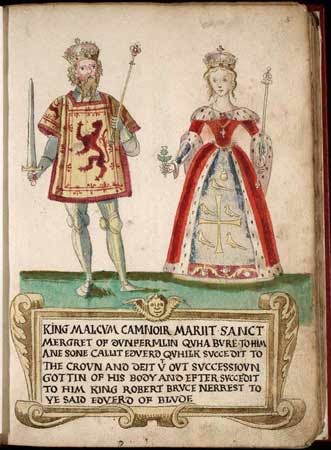 |
| Depiction of Malcolm III and Saint Margaret of Scotland. History also knows him as Malcolm Canmore (Gaelic for great head' or 'chief). |
Malcolm was born in 1031 - possibly on March 26th - as the eldest son of Duncan I of Scotland and Queen Suthen.
His father's reign was not successful, and it ended with the King's death at the hands of his cousin, Macbeth, who seized the throne for himself on August 15, 1040. Malcolm's family unsuccessfully attempted to overthrow Macbeth, and he was sent to a safe haven - possibly in England, at the court of Edward the Confessor.
In 1057, he returned to Scotland, and at the Battle of Lumphanan in Aberdeenshire, he defeated and killed Macbeth, who was succeeded by his stepson, Lulach, until he too was killed by Malcolm on April 23, 1058. Malcolm was now King of Scots and he was crowned as such two days later at Scone.
Before taking the throne, it is likely that the King had been married for some time to Ingibjörg, the daughter of a Norwegian nobleman, Finn Arnesson, who was an adviser to Olaf II and Harald III of Norway, as well as Sweyn II of Denmark. Ingibjörg was also the widow of Thorfinn Sigurdsson – the powerful Earl of Orkney. Because much of north and western Scotland was still under Scandinavian, Norse-Gael, and Gaelic control, this marriage helped to secure peace in those areas for King Malcolm. It also produced three sons: Duncan, Donald, and Malcolm.
Meanwhile, events south of the border would greatly shape the course of Malcolm III's reign. The Norman Conquest of England led by William the Conqueror in the late 1060's and early 1070's resulted in Malcolm granting sanctuary to the Anglo-Saxon royal exiles, including Edgar the Ætheling, who had been elected as King of England after the death of Harold II at the Battle of Hastings and before the takeover by William I on Christmas Day 1066.
In either 1070 or 1071, Malcolm III married for a second time (following the death of Ingibjörg) to Edgar's sister, Margaret of Wessex, with whom he had eight children. Their names marked a change from the Norse or Gaelic names (i.e., Malcolm, Cináed and Áed) that had been the established tradition previously for Scottish royalty, but also marked out their Anglo-Saxon heritage: Edward was named for Queen Margaret's father Edward the Exile, Edmund for her grandfather Edmund Ironside, Æthelred for her great-grandfather Æthelred the Unready, and Edgar for her great-great-grandfather Edgar and her aforementioned brother. The remaining children from this marriage were Alexander, David, Matilda, and Mary.
King Malcolm may have believed that his marriage into Anglo-Saxon royalty and the Anglo-Saxon names of his children could have put him in a position to challenge William the Conqueror, or at least undermine his shaky authority by carrying out raids into England on land and sea without consequence. However in 1072, William I's position was strengthened by his Harrying of the North, and he rode to Scotland and forced Malcolm to sign the Treaty of Abernethy, which stipulated that in return for swearing allegiance to William, he was to be given estates in Cumbria, England.
Nonetheless, Malcolm continued to conduct raids on northern England, with the hope of annexing the northern English counties and pushing Scotland's border further south. In 1080, William sent his eldest son Robert to deal with Malcolm, and a new peace deal was struck, which lasted for over a decade.
During the reign of William Rufus (William II of England), the peace began to break down again in 1092, but an attempt was made to settle the disputes over lands and estates in Cumbria when a meeting was arranged between Malcolm and Rufus in Gloucester. This failed to materialize when Malcolm was informed that Rufus was not negotiating and that the dispute would be judged by English barons. Malcolm left for home angry and humiliated, and he proceeded to raiding the northern counties again.
It was on his return journey from one of these raids that Malcolm was ambushed by Robert de Mowbray, Earl of Northumbria, whose lands had been devastated by Malcolm. This incident became known as the Battle of Alnwick, at which Malcolm III of Scotland was killed on November 13, 1093. He was initially buried at Tynemouth Priory, but was re-interred at Dunfermline Abbey next to his queen, Margaret (who was later beatified and is Scotland's only royal saint), during the reign of his son, Alexander I.
Malcolm was immediately succeeded by his brother as Donald III, who in turn was succeeded by Malcolm's surviving sons - Duncan II, Edgar, Alexander I, and David I. His elder daughter Matilda would marry Henry I of England, and be an ancestor to the English Plantagenet dynasty, beginning with her grandson, Henry II.
In terms of his legacy, Malcolm - despite his efforts - did little to change to political map of Britain. What he did achieve was the founding of a line of kings who would gradually remove Norse influence and power from Scotland. The royal dynasty to which he belonged, the House of Dunkeld, would rule Scotland for nearly 200 more years.
Malcolm III of Scotland is a 26th great-grandfather of Elizabeth II of the United Kingdom.
No comments:
Post a Comment